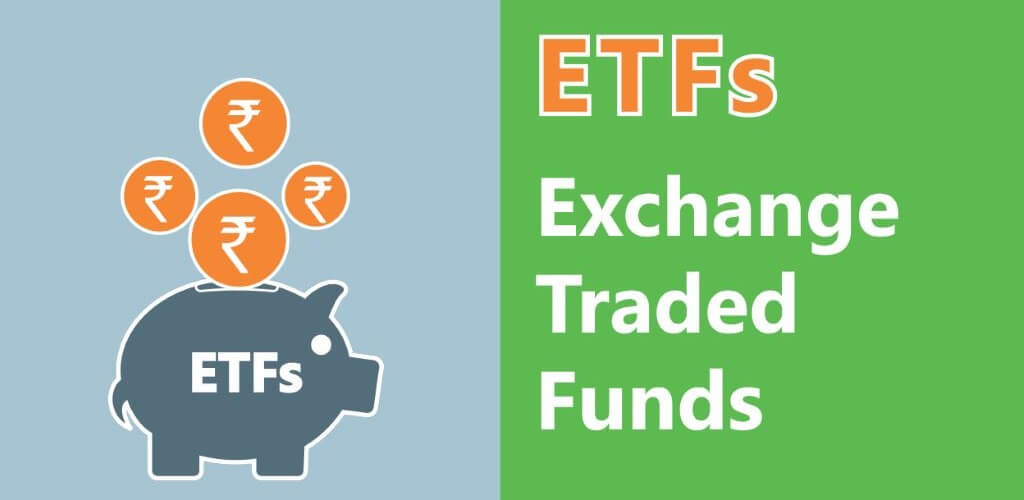Having emerged as a revolutionary investment vehicle, Exchange Traded Funds (ETFs) are continuously reshaping the landscape of financial markets worldwide. Born out of the intersection of traditional mutual funds and individual stocks, ETFs offer investors a unique and flexible way to gain exposure to diverse asset classes, ranging from stocks and bonds to commodities and beyond.
ETFs commonly follow specific indices, sectors, commodities, or other asset classes. The structure of ETFs is designed to mirror the performance of anything from a single commodity’s price to a comprehensive and varied assortment of securities. Investing in an ETF provides you with a package of assets that can be traded during market hours, offering potential risk reduction and exposure management while contributing to the diversification of your investment portfolio.
This post aims to unravel the fundamental aspects of exchange-traded funds, exploring their functioning, types, and much more. As we delve deeper, we will discover how ETFs have become integral tools for investors seeking simplicity, diversification, and cost-efficiency in the dynamic world of finance.
Why Should One Invest In ETFs?
Whether seeking exposure to broad market indices, niche sectors, or thematic strategies, investors can find an ETF that aligns with their investment objectives. Investing in Exchange Traded Funds (ETFs) offers several compelling advantages that make them an attractive option for a wide range of investors.
Here are some key reasons why one might consider investing in ETFs:
- Budget-Friendly: ETFs often have lower expense ratios compared to actively managed funds. The passive investment strategy of the fund, typically tracking an index, results in lower management fees. This cost efficiency can contribute to better overall returns for investors.
- Diversification: ETFs provide a gateway to a varied assortment of asset classes, encompassing both domestic and international stocks, bonds, and commodities. This diversification helps spread risk, reducing the impact of poor performance in any single investment on the overall portfolio.
- Transparency: Because ETFs follow a particular index, there is transparency regarding the securities held within the fund. Moreover, the structure of ETFs requires them to disclose their holdings daily. This transparency allows investors to know exactly what assets they own within the ETF, promoting a clear understanding of their investment.
- Wide Investment Strategies: ETFs offer exposure to a wide range of investment strategies, including passive index tracking, smart beta strategies, and thematic investing. This variety allows investors to choose ETFs that align with their specific investment objectives and preferences.
- Liquidity: Shares of ETFs can be purchased and sold on exchanges at live market prices at any point during trading hours. This intraday trading facility allows investors to have greater control over the timing of their trades, offering flexibility that is not always available with traditional funds.
- Accessibility: ETFs are accessible to investors with various account sizes. With shares trading on the stock exchange, investors can buy and sell ETFs in the same way they transact with individual stocks, making them suitable for both small and large investors.
- Tax Advantages: The “in-kind” creation and redemption process used by ETFs can lead to potential tax advantages. This process allows for the transfer of securities to and from the ETF without triggering capital gains, making ETFs a tax-efficient investment option.
- Reduces Unsystematic Risk: As most ETFs adopt a passive investment strategy, tracking the underlying benchmark index, the risk associated with fund managers making incorrect investment decisions is minimized or eliminated.
Types Of ETFs
Exchange Traded Funds (ETFs) come in various types, each catering to different investment strategies, asset classes, and risk profiles. Here are some common types of ETFs:
Equity ETFs:
Equity ETFs are characterized as passive investment options that blend the features of investing in individual equity stocks and equity mutual funds. Similar to individual company stocks, these ETFs are traded on the stock exchange, allowing investors to buy or sell them at real-time market prices.
Investors often use equity ETFs as a tool for portfolio diversification, gaining exposure to different segments of the stock market without having to buy individual stocks. Examples of equity ETFs include Aditya Birla Sun Life NIFTY Healthcare ETF, Bharat 22 ETF, DSP Nifty 50 Equal Weight ETF, and so on.
Bond ETFs:
Bond ETFs serve as instruments for delivering consistent income to investors, with their income distribution tied to the performance of the underlying bonds. These bonds may encompass government bonds, corporate bonds, and municipal bonds issued by states and local entities, offering diversification in the fixed-income space.
Unlike individual bonds, which have specific maturity dates when the principal is repaid, bond ETFs do not have a maturity date. Investors can hold or trade them indefinitely. Some of the examples of bond ETFs include iShares Convertible Bond ETF, Invesco BulletShares 2023 Corporate Bond ETF, and VanEck Fallen Angel High Yield Bond ETF, to name a few.
Sector ETFs:
Sector ETFs concentrate on a specific sector or industry, such as technology, healthcare, financial services, energy, or consumer goods. These ETFs provide investors with exposure to a particular segment of the stock market, allowing them to target their investments in industries they believe will outperform the broader market.
While sector ETFs are focused on a specific industry, they typically hold a diversified portfolio of stocks within that sector. Due to this diversification, the impact of poor performance from individual companies is reduced. Axis NIFTY Bank ETF (G), DSP Nifty Midcap 150 Quality 50 ETF (G), and Mirae Asset Nifty India Manufacturing ETF (G) are a few examples of sector ETFs.
Commodity ETFs:
These ETFs invest in physical commodities such as gold, silver, oil, or agricultural products. They allow investors to gain access to commodities such as precious metals, energy resources, agricultural products, or other raw materials without directly owning the physical assets.
While investors don’t physically own the commodities, commodity ETFs often use futures contracts or other derivative instruments to replicate the price movements of the underlying physical assets. Like other ETFs, commodity ETFs disclose their holdings regularly, allowing investors to know the specific commodities or futures contracts included in the fund. Some examples of commodity ETFs are the Energy Select Sector SPDR Fund (XLE), iShares Gold Trust (IAU), United States Oil Fund, LP (USO), Invesco DB Agriculture Fund (DBA), and many more.
Currency ETFs:
These ETFs track the performance of a specific currency or a basket of currencies, providing exposure to foreign exchange markets. They enable investors to gain exposure to movements in currency exchange rates without directly engaging in forex trading or holding physical currency.
Commonly, these ETFs track the performance of a currency pair, such as the Euro/US Dollar (EUR/USD) or the US Dollar/Japanese Yen (USD/JPY). Investing in currency ETFs can provide investors with a way to diversify their portfolios internationally, beyond traditional equity and fixed-income investments. Below are some of the best currency ETFs:
- Invesco DB US Dollar Index Bullish Fund (UUP)
- Invesco CurrencyShares Euro Trust (FXE)
- WisdomTree Bloomberg U.S. Dollar Bullish Fund (USDU)
- Invesco CurrencyShares Japanese Yen Trust (FXY)
- ProShares Bitcoin Strategy ETF (BITO)
Inverse ETFs:
Inverse ETFs, also known as short or bear ETFs aim to deliver returns opposite to the performance of the underlying index. They are designed for investors looking to profit from, or hedge against, declining markets. Some well-known examples of inverse ETFs are ProShares Short VIX Short-Term Futures ETF, Dynamic Short Short-Term Volatility Futures ETF, ProShares UltraShort Bloomberg Crude Oil, and so on.
Inverse ETFs use various financial instruments, such as derivatives and futures contracts, to create a short position in the underlying index or assets. This allows the ETF to benefit from price declines. Inverse ETFs are often employed by traders who have a negative outlook on a particular market or anticipate a short-term decline.
Leveraged ETFs:
Leveraged ETFs use financial derivatives to amplify the returns of the underlying index. These ETFs use leverage to increase exposure to the performance of the tracked index, often seeking to deliver returns that are multiple (2x or 3x) of the index’s daily or monthly returns. Some examples include Direxion Daily Technology Bull 3X Shares, ProShares Ultra Technology, MicroSectors FANG+™ Index 3X Leveraged ETN, and many more.
Due to the daily resetting nature and compounding effects, leveraged ETFs are not intended for long-term buy-and-hold strategies. They are more suitable for short-term tactical trades. The compounding effect can cause returns to deviate significantly from the simple multiplication of the index’s returns. Therefore, the leveraged ETFs are considered more suitable for sophisticated investors who understand the complexities of leverage and the potential risks involved.
Risks Associated With Exchange Traded Funds
Exchange-Traded Funds (ETFs) have become increasingly popular investment vehicles due to their flexibility and diversification benefits. However, like any investment, ETFs do carry some risks that investors should be aware of.
Here are some of them:
- Liquidity Risk: Certain ETFs with low trading volumes may exhibit significant bid-ask spreads, implying that you might purchase at the higher end of the spread and sell at the lower end.
- Market Risk: ETFs are subject to market risk, meaning their value can fluctuate based on the performance of the underlying assets they track.
- Tracking Error: Factors such as fees, trading costs, and imperfect replication can result in a tracking error, meaning the ETFs’ performance may deviate from the underlying index.
- Tax Efficiency Risk: ETFs are generally tax-efficient, but in certain situations, investors may face capital gains distributions. This can occur if the ETF sells securities at a profit and passes the capital gains to investors.
- Regulatory Risk: Regulatory changes or new legislation can impact the operations and performance of ETFs. Changes in tax laws or regulations governing the underlying assets can affect the profitability and tax efficiency of the ETFs.
- Currency Risk: Fluctuations in exchange rates or changes in currency values can impact the returns of the ETF when translated back to the investor’s base currency.
Basic Functioning Of Exchange Traded Funds
Exchange Traded Funds (ETFs) function as investment funds that are traded on stock exchanges, combining elements of individual stocks and traditional mutual funds. The basic working of ETFs involves the following three key steps:
- ETF Creation & Underlying Assets: An ETF is created by an issuer, often an asset management company or financial institution. The issuer designs the ETF to track a specific index, sector, commodity, or asset class. It then assembles a portfolio of underlying securities that closely mirrors the composition of the target index or asset class.
- Formation Of ‘Creation Units’: To create new shares of the ETF, the issuer assembles large blocks of shares known as “creation units.” These creation units are typically exchanged in-kind for a basket of the ETF’s underlying assets.
- Trading: Investors have the option to purchase a share in the ETF basket similar to acquiring stock in a company. Similar to stocks, the ETF is traded on an exchange, allowing buyers and sellers to engage in trading activities throughout the day.
How To Choose The Right ETF?
Choosing the right Exchange Traded Fund (ETF) involves careful consideration of various factors to align with your investment goals, risk tolerance, and overall portfolio strategy. Here are some of these factors:
- Expense Ratios & Fees: Always compare expense ratios and fees among similar ETFs. Lower expenses can contribute to better overall returns. However, consider other factors, such as tracking error and liquidity, alongside costs.
- Liquidity & Volume: Assess the liquidity of the ETF by considering its trading volume and bid-ask spreads. Higher trading volume and tighter spreads generally indicate greater liquidity, making it easier to buy or sell shares at the desired price.
- Review Past Performances: Consider the historical performance of the ETF, but don’t rely solely on past returns. Look for consistency in performance and how well it aligns with the stated investment strategy.
- Analyse Your Risk Tolerance: Assess your risk tolerance to determine how much volatility and market fluctuations you are comfortable with. Different ETFs carry varying levels of risk, and choosing the right one depends on your risk appetite.
- Check The Issuer’s Reputation & Stability: Evaluate the reputation and stability of the ETF issuer. Established and reputable issuers often provide greater confidence in the ETF’s management and operational practices.
- Read The Prospectus & Documentation: Carefully review the ETF’s prospectus, factsheet, and other relevant documentation provided by the issuer. It contains important information about the ETF’s investment strategy, risks, fees, and other details that can help you make an informed decision. Also, pay attention to the fund manager’s approach and the specific criteria for index inclusion.
- Consult With A Financial Advisor: If needed, seek advice from a financial advisor. A professional or an expert can offer sound and personalized guidance on the basis of your financial conditions and future objectives.
Frequently Asked Questions
ETFs can hold a variety of assets, including stocks, bonds, commodities, currencies, and other financial instruments. The specific assets depend on the ETF’s investment objective.
The majority of ETFs are passively managed. However, some ETFs like PIMCO Active Bond ETF (BOND) and Cambria Foreign Shareholder Yield ETF (FYLD) are actively managed.
Passively managed ETFs aim to replicate the performance of a specific index, while actively managed ETFs involve fund managers making investment decisions to outperform the market.
Yes, investors can buy partial shares of an ETF on the stock exchange. This allows for greater flexibility in investing small amounts of money.
ETFs can be suitable for both short-term trading and long-term investing, depending on the investor’s goals. Some ETFs are designed for long-term investors, while others, such as leveraged or inverse ETFs, are more suitable for short-term trading.
An ETF’s cost is typically expressed through its expense ratio, representing the percentage of assets under management (AUM) that investors pay annually to cover the fund’s administrative and operational expenses. This ratio, in general, covers various costs and is lower for the majority of ETFs, making them more cost-effective.
However, the specific expense ratio can vary widely based on the ETF type and its investment approach. For example, while the expense ratio of passive ETFs is typically low, actively managed ETFs often have higher expense ratios.
No, participating in ETF investments without an active trading account and a ‘Demat Account’ is not viable. If you lack a demat account, you may explore alternative passive investment options.
Given that ETFs invest in diverse securities like equities, bonds, and commodities, they are susceptible to market volatility. Therefore, they cannot be deemed as inherently safe investments.








